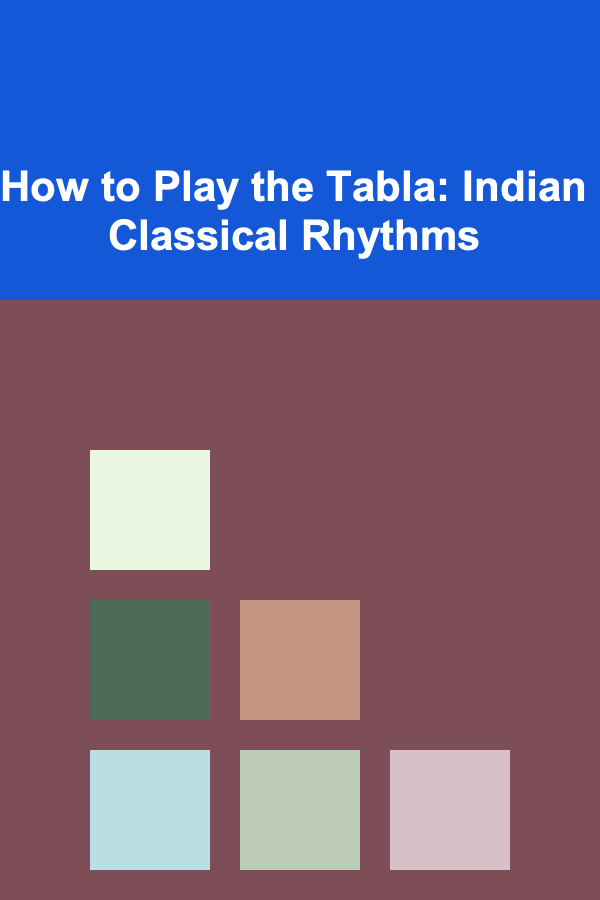
How to Play the Tabla: Indian Classical Rhythms
ebook include PDF & Audio bundle (Micro Guide)
$12.99$6.99
Limited Time Offer! Order within the next:

The Tabla is one of the most expressive and intricate percussion instruments in the world. Originating from the Indian subcontinent, this two-piece drum set is a core element of Indian classical music and has evolved into a sophisticated art form in its own right. Whether you're a beginner or an advanced musician, learning how to play the Tabla can open up an entirely new dimension of rhythm and musicality.
This comprehensive guide explores the history, components, techniques, and rhythms of the Tabla. By understanding its rich cultural context and the unique skills required to play it, you'll be well on your way to mastering the instrument.
Understanding the Tabla
The Tabla consists of two drums: the right drum (called the Dayan ) and the left drum (called the Bayan). Each drum has distinct tonal qualities, and together they create a complex range of sounds used to produce rhythms in Indian classical music. The right drum is smaller and tuned to a higher pitch, while the left drum is larger and produces a deeper, bass-like tone.
The Right Drum (Dayan)
The Dayan, often referred to as the "treble" drum, is typically made from wood and has a much smaller diameter than the Bayan. It is tuned to a specific pitch, which can be adjusted by tightening or loosening the tuning pegs on the sides of the drum. This drum's sound is sharp and crisp, providing the higher-pitched tones that drive the rhythm.
The Left Drum (Bayan)
The Bayan, also known as the "bass" drum, is made from metal or clay, which gives it a rich, resonant tone. The Bayan is typically larger than the Dayan, and it is used to produce the deeper, more resonant sounds in Indian rhythms. The pitch of the Bayan can be modified by manipulating the pressure and positioning of the fingers and palms, creating variations in sound.
The Tabla's Role in Indian Classical Music
Indian classical music is based on two fundamental components: ragas (melodies) and talas (rhythms). The Tabla plays a crucial role in supporting the tala, providing the rhythmic foundation upon which the melody is built. The relationship between the raga and tala is intricate, with the Tabla player responding to the melodic phrases played by the main musician, whether that be a sitar, flute, or voice.
Tabla Techniques and Hand Positions
Playing the Tabla requires intricate finger and hand movements that produce distinct sounds. Each sound, or bol, is made by striking the drums in different ways. Understanding these fundamental techniques is essential for learning how to play the Tabla.
Basic Hand Positions
-
Dayan (Right Drum) Hand Positions:
- Index and Middle Finger: These are used to strike the center of the Dayan to produce a clear sound.
- Thumb: The thumb plays an essential role in creating sharp, high-pitched tones when used to strike the edge of the Dayan.
- Ring and Little Fingers: These fingers help control the tone by resting lightly on the drum during certain strokes.
-
Bayan (Left Drum) Hand Positions:
- Palm and Fingers: The fingers and palm of the left hand are used to strike various points of the Bayan. The full palm creates a deep, resonant sound, while the fingers produce more nuanced, pitched sounds.
Key Strokes (Bol)
The unique sounds of the Tabla are created by a series of strokes, called bols. These are specific syllables that represent the sounds made by different hand and finger movements. Here are some of the most common bol patterns:
Dayan Bol:
- Na: A sharp stroke produced by the index and middle fingers striking the center of the Dayan.
- Tin: Produced by striking the edge of the Dayan with the index or middle finger, creating a bright, clear tone.
- Taa: A clear, full note produced by striking the Dayan with the middle finger while pressing down slightly with the thumb.
- Dha: A combined sound produced by striking both the Dayan and Bayan simultaneously.
Bayan Bol:
- Ge: A deep, resonant sound made by tapping the Bayan with the base of the fingers.
- Dhin: A heavier sound produced by the full palm striking the Bayan.
- Tun: This is a low-pitched sound created by the fingertips tapping on the Bayan.
The Tabla's Rhythmic Structure: Tala
In Indian classical music, the concept of Tala refers to the rhythm or time cycle. The Tala is the framework within which the Tabla player creates variations and improvisations. Each Tala consists of a set number of beats (known as matras) arranged in a specific pattern.
Common Talas
-
Teentaal (16 beats): This is one of the most common Talas in Indian classical music. It consists of 16 beats divided into four sections of four beats each.
- Bol Pattern: Dha Dhin Dhin Dha | Dha Dhin Dhin Dha | Dha Tin Tin Ta | Dha Dhin Dhin Dha.
-
Jhaptaal (10 beats): A slightly more complex Tala, Jhaptaal has 10 beats divided into sections of 2, 3, 2, and 3 beats.
- Bol Pattern: Dhin Na | Dhin Na | Tin Na | Dhin Na.
-
Ektaal (12 beats): Ektaal is often used in classical vocal music. It is divided into six beats, followed by six beats.
- Bol Pattern: Dha Dhin Dhin Dha | Dha Dhin Dhin Dha.
-
Rupak (7 beats): This Tala has an uneven structure and is often used in more complex pieces.
- Bol Pattern: Tin Tin Na | Tin Na.
The Role of the Tabla Player in Tala
The Tabla player is responsible for setting the rhythm and maintaining the tala throughout the performance. While the main musician (or vocalist) plays or sings a raga, the Tabla player interacts with the melody by improvising within the constraints of the tala. This interplay between the raga and tala is one of the hallmarks of Indian classical music.
The Tabla player will often break the tala, introducing variations in the rhythm, known as tihai or paran, to create moments of tension and release. This keeps the audience engaged and adds an element of unpredictability to the performance.
Learning to Play the Tabla: A Step-by-Step Guide
1. Understanding Basic Bol Patterns
As with any musical instrument, the first step is mastering the basic sounds or bol patterns. Start by learning the most common bol patterns used in Indian classical music, as mentioned earlier. Practice each stroke individually, focusing on the precision of your hand movements and ensuring that each bol is distinct and clear.
2. Developing Finger Strength and Control
The Tabla requires considerable finger strength and dexterity. Early on, practice exercises that focus on building finger strength, agility, and control. Slow, deliberate practice will help you gain precision in producing each sound.
3. Mastering Simple Talas
Once you have a solid grasp of the basic bol patterns, move on to learning simple Talas such as Teentaal or Jhaptaal. Begin by counting the beats out loud as you play, and gradually reduce reliance on verbal counting as you internalize the rhythm. Focus on maintaining steady, even beats, and gradually increase your speed as your comfort level improves.
4. Improvisation and Variation
Indian classical music places a great emphasis on improvisation. After mastering the basic strokes and Talas, experiment with creating variations. Try to play around with rhythmic patterns, exploring different combinations of bol strokes within the boundaries of a specific Tala. Listen to the rhythms of experienced Tabla players to understand the types of variations and flourishes that can be introduced.
5. Advanced Techniques and Rhythmic Structures
As you progress, you'll begin to incorporate more advanced techniques such as tihai (a rhythmic phrase repeated three times) and paran (a fixed composition for the Tabla). These techniques add complexity to your playing and are often used to create dramatic effects in a performance.
6. Playing Along with Other Instruments
Finally, once you're confident in your Tabla playing, try playing alongside other instruments, whether in an ensemble or with recordings. This will help you better understand how the Tabla interacts with other parts of the musical composition. Listening to the interplay between your instrument and others will enhance your ability to improvise within the framework of a performance.
Conclusion
Learning to play the Tabla is a challenging yet immensely rewarding journey. It requires patience, dedication, and an understanding of the deep cultural and rhythmic traditions of Indian classical music. As you progress, you'll not only develop technical skills but also gain an appreciation for the art of rhythm, its connection to melody, and its role in the larger context of Indian music.
By mastering the fundamentals of hand positions, bol patterns, and Talas, and engaging in creative improvisation, you'll unlock the full potential of the Tabla. Its rich sound and intricate rhythms are sure to bring depth and complexity to your musical expression. Whether you play it for personal enjoyment or as part of a professional performance, the Tabla offers endless possibilities for rhythmic exploration.

How to Plan a Family DIY Home Improvement Project
Read More
How to Reduce Noise Between Floors with Simple Solutions
Read More
How to Stage Your Home to Appeal to Young Families
Read More
How To Explore the Gritty Sounds of Delta Blues
Read More
Organizing Your Life: A Step-by-Step System
Read More
10 Tips for a Daily Planner for Entrepreneurs: Prioritizing Tasks & Growing Your Business
Read MoreOther Products

How to Plan a Family DIY Home Improvement Project
Read More
How to Reduce Noise Between Floors with Simple Solutions
Read More
How to Stage Your Home to Appeal to Young Families
Read More
How To Explore the Gritty Sounds of Delta Blues
Read More
Organizing Your Life: A Step-by-Step System
Read More